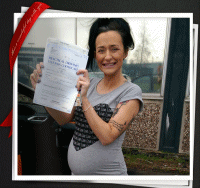Driving Lessons For You - Pregnant Drivers
Learning to drive while pregnant is certainly possible but requires careful thought. Many women are keen to have their driving licence for when the baby arrives and they have no time on their hands. A car can make life so much easier.
It gives us a few things to consider, on driving lessons and your driving test, especially as your baby continues to grow.
Driving Lessons - Pregnant Learner
In a crash it is important to reduce the primary risks to your baby. Hitting the bottom of the steering wheel, minimising your forward movement and letting the air bag operate as intended. You should position yourself correctly and review and modify your position as you get bigger. Move your seat as far back as is comfortable/effective and tilt it slightly away from the steering wheel. Try to be 25 centimeters from the steering wheel, making sure the steering wheel is tilted toward your breastbone rather than toward your abdomen. If your baby gets too big to position yourself correctly for effective, safe driving, if you can't fully control the pedals because of your bump, you need to consider stopping your lessons until after the birth. Pedal extenders are not an option for sitting your test and would be considered a modification to your vehicle for the purposes of the test. Big soled shoes, higher heels or a cushion on the seat are available options but you must be in full control of the pedals.
Wear your seatbelt properly. Official advice states that the belt will have no adverse effects on a normal pregnancy. When pregnant, the lap belt should be secured below your baby, low and snug on your hipbones. Never wear the belt across or above your belly. Always use the shoulder belt, which should fit snugly between your breasts.
As you get bigger, it’s important to keep healthy circulation, particularly in your legs, take regular breaks even if just for a couple of minutes, so you can stretch your legs. Toilet breaks are relatively easy to plan in a lesson so you can do both at the same time.
Fill up before hitting the road. It is not just the car that needs fuel. Eat before you leave the house and maybe pack a snack for the lesson (2 hours). Drink plenty of water to stay hydrated. It helps reduce distractions due to pangs and fatigue.
Try and pass your driving test before the third trimester. Although there is no hard and fast rule, many women stop driving around 30 weeks. This may be because of advice received in regular check ups. If there is the slightest problem with your pregnancy the doctor will advise you to stop driving. I have found roughly 50% of pregnant women are advised to stop driving in the latter stages of pregnancy by their GP. This is after they have already spent alot of money on lessons and are just getting into the swing of things.
In the last trimester fatigue, various distractions and a lack of focus can start to effect a pregnant womens driving ability quite dramatically. Some describe it as 'baby brain' a combination of hormonal effects, tiredness and other stuff. If this happens regularly you need to consider stopping your lessons and plan on starting to drive again after giving birth. A good instructor will only present a candidate for test if they remain safe.
If you're in a collision - even if it’s a minor one and you feel OK - have the baby's heartbeat checked to make sure no damage has been done. Even if you don't feel you've been hurt, research suggests that pregnant women in crashes without documented injuries are at greater risk of premature labour caused by a placental abruption.


